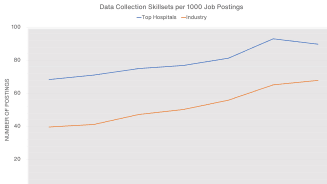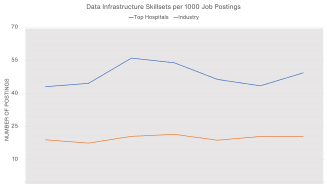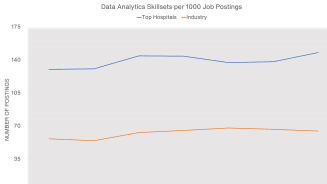Facing a Worker Shortage, Healthcare Companies Focus on Digital Job Skills

As healthcare organizations digitalize their business and face global workforce shortages, our analysis finds they are rapidly recruiting new talent with specific data skillsets.
Key Takeaways
-
Facing workforce shortages, healthcare organizations are actively recruiting talent with data skillsets.
-
Top innovative hospitals are recruiting at higher rates for roles that use data in more advanced ways.
-
There is an opportunity for all healthcare organizations to synch their digital business and talent strategies to deliver better patient care.
Companies across all industries are digitalizing their business and, in turn, hiring talent with specific skills to help them deliver on their strategy. This is particularly true in the healthcare industry, which is undergoing rapid digital transformation and addressing disruption to their business and workforce from the pandemic.
Amid this volatility, two workforce trends have important implications for the future of patient care. First, workforce shortages are plaguing the healthcare industry. Burnout and stress from the pandemic have led to a shortfall of healthcare workers. Globally, the World Health Organization projects this shortfall to rise to 10 million care workers by 2030. The worker shortage is adversely affecting the quality and accessibility of care, leading to longer wait times, increased health costs and poorer health outcomes for patients.
Second, the digitalization sweep across the industry means hospitals and other healthcare organizations are generating vast amounts of data from electronic health records, medical devices, wearables, operational data and other sources. With the ability to collect, analyze and interpret large of amounts of data, healthcare organizations can improve the accessibility and quality of healthcare. This can be done through using internal data assets to forecast patient needs, optimize scheduling or custom-tailor treatment plans for patients. However, attracting workers with these in-demand skills is challenging in today’s competitive labor market. Fortunately, we see there is progress being made to recruit and retain employees with the requisite digital skills healthcare organizations need.
Recruiting Talent with Digital Skills That Align to Strategy
At Aon, we use a framework known as the Data Value Chain to help organizations across all industries hire the right talent. This helps firms realize value from their internal data assets, enabling many value-added activities from digitalization. The framework consists of three tiers that categorize digital skills and jobs. These include:
Tier 1: Data collection
This includes more basic digital skills. Most healthcare systems today have made the requisite investments to digitize patient records, conduct admissions check-ins and more. Now they are actively recruiting for jobs such as data processing that use these skills.
Tier 2: Data infrastructure
This includes skills that focus on managing and structuring data to make it digestible and actionable for all stakeholders. Jobs in this tier include data engineer and software engineer.
Tier 3: Data analytics
This includes skills that use data and tools to drive key decisions, such as what investments to make to improve patient outcomes or how to speed up insurance claims and payments. Jobs include business intelligence analysts and data scientists.
To better understand the pace at which healthcare companies are recruiting for these types of jobs, Aon’s Human Capital Solutions team used data from Lightcast to analyze job openings over the past seven years at U.S. News & World Report’s Top 25 Most Innovative Hospitals in the United States and the healthcare industry in the U.S. overall.
Our analysis used a proprietary, AI-enabled skills taxonomy solution to map skills listed in these job postings to the Data Value Chain framework. We find hiring for data-centric skillsets is not just a passing trend, but rather a reflection of a larger shift in the healthcare industry toward using data to inform decision making and drive better patient outcomes. Since 2016, growth in job postings requiring data-related skills outpaced growth in overall healthcare job postings, which was 4 percent. Demand for jobs with Tier 1 skills witnessed the largest overall growth, increasing at an annualize rate between 7 to 9 percent. However, the biggest growth for jobs with data skills is seen among the Top 25 hospitals. After accounting for market size, our analysis shows this group is three times more likely to seek talent with data skillsets.
10M
Projected healthcare worker shortage by 2030
Source: World Health Organization
With the worst of the pandemic behind us, hospitals and other healthcare systems have renewed their focus on digitalizing their organizations.
Top Hospitals in the US Lead in Hiring for Data Skills



While many healthcare organizations across the industry are well positioned to hire skills Tier 2 and Tier 3 of the Data Value Chain, there may be a knowledge gap when it comes to knowing how to effectively structure and recruit for these roles. There could also be reluctance to hire too many roles that tend to command higher pay.
If we look at pay levels for the representative jobs in each tier, it is not surprising that the value of the jobs is higher for those in the more advanced tier. However, we know from our data and client engagements, the return on investment for these more advanced data skills is both quickly realized and sustainable over time if a company is ready to deploy advanced data skills to fulfill the business strategy.
Using Aon’s Radford Global Compensation Database, which represents compensation data from more than 19 million employees across 6,400 participating organizations, we find data analytics professionals earn a median base pay that is around one and a half times the base pay for a data center operations professional.
Focusing on the Right Skills to Fuel Growth in Healthcare
Healthcare organizations are at an important inflection point. With continued economic uncertainty, leading organizations recognize the importance of having an impactful digital experience at the core of their business, patient and workforce strategy.
Start by understanding how jobs can facilitate your organization’s movement up the Data Value Chain. Then take time to truly learn the cost and value of the jobs. This will position your firm to provide both a leading patient and workforce experience.
To learn more about how Aon can help your healthcare organization with your talent strategy, please write to [email protected].
General Disclaimer
The information contained herein and the statements expressed are of a general nature and are not intended to address the circumstances of any particular individual or entity. Although we endeavor to provide accurate and timely information and use sources we consider reliable, there can be no guarantee that such information is accurate as of the date it is received or that it will continue to be accurate in the future. No one should act on such information without appropriate professional advice after a thorough examination of the particular situation.
Terms of Use
The contents herein may not be reproduced, reused, reprinted or redistributed without the expressed written consent of Aon, unless otherwise authorized by Aon. To use information contained herein, please write to our team.
3x
Top hospitals are three times more likely to seek talent with data skillsets
Source: Aon Data Analysis
Aon's Better Being Podcast
Our Better Being podcast series, hosted by Aon Chief Wellbeing Officer Rachel Fellowes, explores wellbeing strategies and resilience. This season we cover human sustainability, kindness in the workplace, how to measure wellbeing, managing grief and more.
Cyber Labs
Stay in the loop on today's most pressing cyber security matters.
Cyber Resilience
Our Cyber Resilience collection gives you access to Aon’s latest insights on the evolving landscape of cyber threats and risk mitigation measures. Reach out to our experts to discuss how to make the right decisions to strengthen your organization’s cyber resilience.
Employee Wellbeing
Our Employee Wellbeing collection gives you access to the latest insights from Aon's human capital team. You can also reach out to the team at any time for assistance with your employee wellbeing needs.
Environmental, Social and Governance Insights
Explore Aon's latest environmental social and governance (ESG) insights.
Q4 2023 Global Insurance Market Insights
Our Global Insurance Market Insights highlight insurance market trends across pricing, capacity, underwriting, limits, deductibles and coverages.
Regional Results
How do the top risks on business leaders’ minds differ by region and how can these risks be mitigated? Explore the regional results to learn more.
Human Capital Analytics
Our Human Capital Analytics collection gives you access to the latest insights from Aon's human capital team. Contact us to learn how Aon’s analytics capabilities helps organizations make better workforce decisions.
Insights for HR
Explore our hand-picked insights for human resources professionals.
Workforce
Our Workforce Collection provides access to the latest insights from Aon’s Human Capital team on topics ranging from health and benefits, retirement and talent practices. You can reach out to our team at any time to learn how we can help address emerging workforce challenges.
Mergers and Acquisitions
Our Mergers and Acquisitions (M&A) collection gives you access to the latest insights from Aon's thought leaders to help dealmakers make better decisions. Explore our latest insights and reach out to the team at any time for assistance with transaction challenges and opportunities.
Navigating Volatility
How do businesses navigate their way through new forms of volatility and make decisions that protect and grow their organizations?
Parametric Insurance
Our Parametric Insurance Collection provides ways your organization can benefit from this simple, straightforward and fast-paying risk transfer solution. Reach out to learn how we can help you make better decisions to manage your catastrophe exposures and near-term volatility.
Property Risk Management
Our Property Risk Management collection gives you access to the latest insights from Aon's thought leaders to help organizations make better decisions. Explore our latest insights to learn how your organization can benefit from property risk management.
Technology
Our Technology Collection provides access to the latest insights from Aon's thought leaders on navigating the evolving risks and opportunities of technology. Reach out to the team to learn how we can help you use technology to make better decisions for the future.
Top 10 Global Risks
Trade, technology, weather and workforce stability are the central forces in today’s risk landscape.
Trade
Our Trade Collection gives you access to the latest insights from Aon's thought leaders on navigating the evolving risks and opportunities for international business. Reach out to our team to understand how to make better decisions around macro trends and why they matter to businesses.
Weather
With a changing climate, organizations in all sectors will need to protect their people and physical assets, reduce their carbon footprint, and invest in new solutions to thrive. Our Weather Collection provides you with critical insights to be prepared.
Workforce Resilience
Our Workforce Resilience collection gives you access to the latest insights from Aon's Human Capital team. You can reach out to the team at any time for questions about how we can assess gaps and help build a more resilience workforce.
More Like This
-

Article 24 mins
Capturing Carbon on the Critical Pathway to Net Zero
As the world races to reduce climate risks and limit CO<sub>2</sub> emissions, the demand for scalable and cost-effective decarbonization technologies is increasing. Carbon capture projects form an important part of the low carbon energy transition, bringing both challenges and opportunities.
-

Article 13 mins
Protecting North American Contractors from Extreme Heat Risks with Parametric
Growing extreme heat conditions have escalated risks, delays and costs for the construction industry in North America. Parametric insurance can help protect against such risks, offering contractors and building owners agility, efficiency and flexibility.
-

Article 21 mins
How Insurance Can Help Hedge Potential Exposures Under the New Unified Patent Court System
The launch of the Unified Patent Court allows for a new patent filing process across Europe using a centralized system. While this brings significant financial and operational benefits, navigating these changes will demand a robust litigation risk management strategy.






































































































